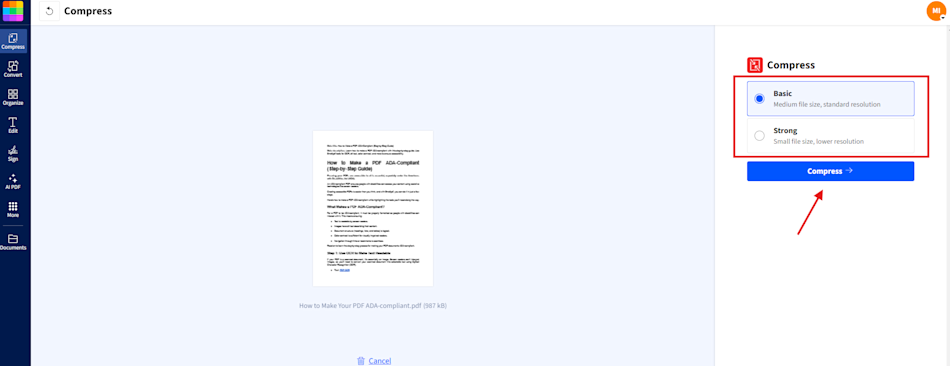
8 Common Issues in PDF to Word Conversion and How to Fix Them
by Stéphane Turquay
Fix PDF to Word formatting issues fast. Here's why they happen and how you solve garbled text, spacing errors, or missing images with Smallpdf.
Formatting issues, missing fonts, and other glitches can often disrupt your PDF to Word conversion, leaving you frustrated.
Smallpdf makes it easy to fix PDF to Word conversion problems, and this guide shows 8 common errors and how to solve them.
Common PDF to Word Formatting Issues
Most problems fall into these categories. And if you spot your problem here, keep reading to find out how to fix it:
- Garbled or misaligned text: Fonts or wrapping don’t transfer correctly
- No spaces after copying text: Text clumps together when pasted
- Missing or misplaced images: Graphics disappear or move around
- Wrong or broken fonts: Unembedded fonts change unexpectedly
- Tables or columns break apart: Complex layouts don’t translate cleanly
- Extra line or page breaks: Paragraph spacing changes
- Bullet points misformatted: Lists lose indentation or structure
- Large file size or slow conversion: Files take too long or fail to convert
What Causes PDF to Word Conversion Issues?
PDF to Word formatting issues happen because of the fundamental differences between these two document formats.
PDFs are like digital snapshots with fixed layouts, preserving every element exactly where it was placed. Word documents, on the other hand, use a reflow system that dynamically adjusts content based on page size, margins, and user edits.
When conversion software tries to rebuild a static PDF layout into Word’s flexible structure, several problems can occur:
- Static vs Dynamic Nature: PDFs maintain precise positioning of text, images, and formatting elements, while Word documents are designed to be easily edited with content that can shift and reformat automatically.
- Complex Layouts: Documents with multiple columns, tables, custom fonts, or intricate designs are particularly prone to formatting errors during the conversion process.
- Conversion Process: The software attempts to interpret and reconstruct each element from the PDF’s fixed structure, which can lead to misaligned text, incorrect spacing, and font discrepancies.
Understanding these challenges helps you choose the right PDF tools and apply the right fixes when issues arise.
8 Common PDF to Word Formatting Issues (And Quick Fixes)
1. Garbled or Misaligned Text
One of the most common frustrations of PDF to Word conversion is seeing jumbled or improperly aligned text. This often happens when the font in the PDF is unsupported or when text wrapping doesn’t translate well.
Quick Fix:
Use our PDF to Word to maintain font integrity during conversion.
For scanned documents, try our PDF OCR feature to ensure the text is editable and accurately recognized.
2. Copying From PDF to Word Results in No Spaces
When copying text from a PDF and pasting it into Word, you might find text clumped together with no spaces between words.
Quick Fix:
Use the dedicated PDF to Word converter rather than manually copying and pasting. Our tool ensures proper spacing and formatting of all converted text.
3. Images Missing or Misaligned
Sometimes, charts, logos, or images included in the PDF don’t appear or are misplaced in the Word document.
Quick Fix:
Always use a high-resolution PDF when uploading.
For image-heavy documents, use our PDF Editor to reposition or adjust visuals before converting.
4. Disjointed Fonts or Wrong Typeface
If you notice unusual fonts or broken characters post-conversion, it’s likely because the source font was not embedded in the PDF.
Quick Fix:
Use our PDF OCR feature, which ensures better text and font recognition from scanned or image-based PDFs.
Post-conversion, you can tweak fonts in Word to match your desired style.
5. Tables and Columns Not Translating Properly
Tables and column-based layouts, like those found in resumes or reports, don’t always convert seamlessly.
Quick Fix:
Try manually formatting the table or columns in the Word document after conversion.
Split overly complex tables into simpler segments in the PDF before beginning the conversion.
6. Breaks Between Lines or Words
Poor line breaks or paragraph spacing might cause the Word document to look disorganized, especially in justified text.
Quick Fix:
Use the “Format” feature in Word to adjust line and paragraph spacing.
Alternatively, use our PDF Editor to clean up your PDF before starting the conversion process.

Breaks between lines or words
7. Formatting Glitches in Bullet Points or Lists
Lists and bullet points often lose their structure, leading to messy-looking documents.
Quick Fix:
Convert your PDF to a Word file, which retains bullet points more accurately.
Reapply list formatting using Word’s built-in tools, ensuring proper alignment and spacing.
8. File Too Large or Slow Conversion
Larger files can occasionally slow down the process or fail entirely.
Quick Fix:
Use our Compress PDF before attempting to convert. This reduces file size without compromising quality, ensuring a smooth, faster conversion.

Compress your PDF before attempting to convert
How to Prevent and Fix PDF to Word Formatting Problems
Even with the best converter, some formatting issues might slip through. Here’s how to fix them manually in Word, or what to do before saving your document as a PDF in the first place:
1. Show Hidden Formatting
Click the paragraph symbol (¶) in Word’s Home tab to reveal hidden formatting like extra spaces, section breaks, and line breaks. This makes it easier to identify what’s causing alignment issues.
2. Choose the Right Conversion Settings
When converting, look for options like “Retain Page Layout” (keeps original formatting) or “Retain Flowing Text” (allows content to reflow naturally). Choose based on whether you need exact formatting or editable content.
3. Remove Unwanted Breaks
Use Find and Replace (Ctrl+H) to search for section breaks (^b) and page breaks (^m). Replace them carefully, as removing them can affect your document’s structure.
4. Rebuild Messy Tables
If tables look messy after conversion, select the table and use Word’s Table Tools to adjust column widths, alignment, and borders. Sometimes it’s faster to recreate simple tables from scratch.
5. Use Standard Fonts
Stick to widely supported fonts like Arial, Calibri, or Times New Roman. Custom or decorative fonts may not render properly after conversion.
6. Avoid Complex Layouts
Multi-column text boxes, background images, or layered objects increase the chance of shifting content. Simplify the design before exporting to PDF.
7. Embed Fonts Before Saving as PDF
In Word, go to “File,” then “Options,” “Save,” and “Embed fonts in the file” to lock in typefaces and keep them consistent across devices.
8. Compress Large Images
Oversized images can slow conversion and distort alignment. Use Smallpdf’s Compress PDF tool first for a cleaner result.
9. Check Alignment and Spacing Before Export
A quick visual scan for irregular indents, tabs, or double spaces helps prevent reflow problems once the file is converted.
Fix Formatting Issues Faster with Smallpdf
At Smallpdf, our PDF Converter was designed with simplicity and efficiency in mind. It’s as easy as dragging and dropping your file onto our platform, and our advanced OCR technology handles even the trickiest conversions. Here’s how our tools tackle specific formatting problems:
- Scanned PDFs: Our PDF OCR feature recognizes text from images and maintains better formatting during conversion.
- Large Files: Use our Compress PDF tool first to reduce file size without losing quality, ensuring faster, more reliable conversions.
- Complex Layouts: Our PDF Editor lets you simplify layouts before converting, reducing the chance of formatting errors.
- Top-Quality Results: Your output will look as close to the original as possible.
- Secure & Private: All files are automatically deleted within one hour of processing.
- Accessible Everywhere: Convert files on Windows, Linux, Mac, and even mobile devices.

How Smallpdf simplifies PDF to Word conversion
Ready to convert PDFs without the hassle? Start your free trial to access all Smallpdf tools.
FAQs: PDF to Word Formatting
Can Smallpdf convert scanned PDFs into editable Word files?
Yes! Our PDF OCR allows you to extract and convert text from scanned PDFs into editable Word documents.
How do I fix alignment issues in converted Word documents?
Use Word’s “Align Text” or “Format Paragraph” tools to adjust alignment manually. Alternatively, edit the original PDF with our PDF Editor before conversion.
Can I convert password-protected PDFs?
Yes! Use our Unlock PDF to safely remove password protection before converting.
What browsers work best with Smallpdf?
Smallpdf works seamlessly on all major browsers. For the smoothest experience, ensure you’re using the latest version of Chrome, Firefox, or Safari.
How do I copy from PDF to Word without losing formatting?
Instead of copying and pasting, use a dedicated PDF to Word converter like Smallpdf. These preserve formatting much better than manual copy-paste methods.
Why does my PDF look different in Word?
PDFs use fixed layouts while Word documents reflow content dynamically. This fundamental difference means some formatting changes are inevitable during conversion.



